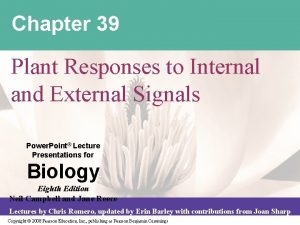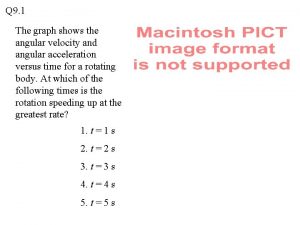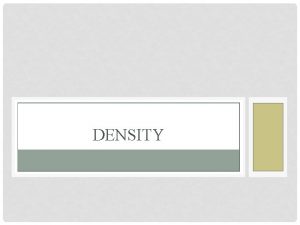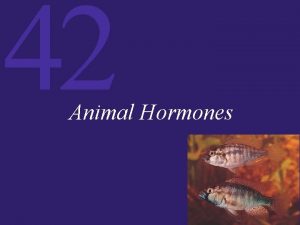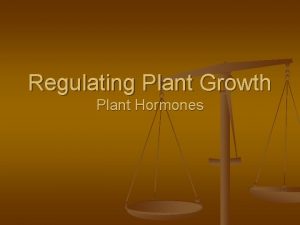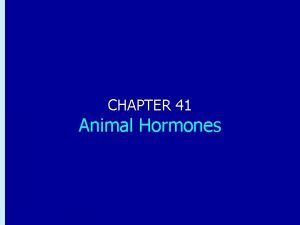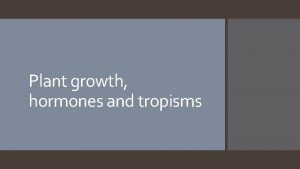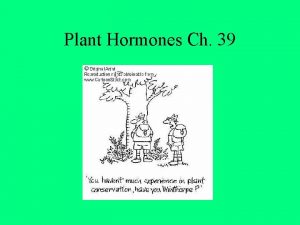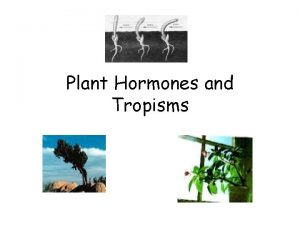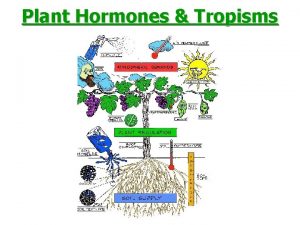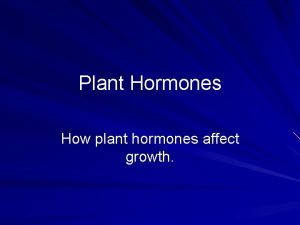Plant hormones Plant hormones compared to animal hormones











- Slides: 11

Plant hormones

Plant hormones compared to animal hormones Similarities with animal hormones • organic • Signal molecules • Target cells are distant to the source • Differences to plant hormones • Don’t travel in general circulation • Are not produced by an endocrine gland • Are not polymers

• Most cells in a plant are capable of making growth regulators/hormones • Small in size they can diffuse readily through the cell wall to influence nearby cells • Can transport through xylem or phloem to affect more distant cells

Auxin response in a plant cell

Types plant hormones/growth regulators Plant growth regulator Produced in Transport in plant effects Auxins Apical tip Young leaves Tip to base through parenchyma cells Stimulates cell elongation, cell division in the cambium and differentiation of phloem and xylem Trophic response to light and gravity Suppress growth of lateral buds Delay leaf senescence and fruit ripening: stimulates growth of flower parts Gibberellins Young leaves, roots, shoots and embryo seed Xylem and phloem Promotes cell division and elongation in plant shots Extend internodes and can rise flower heads Cytokinins Roots xylem Stimulate cell division and the middle layer of cells in leaves. Tend to concentrate starch in seeds and young fruit Abscisic acid Older leaves, root cap and stem Vascular tissue Generally acts as an inhibitor Promotes the closer of the stomata(especially in water stress Stimulates dormancy in seeds and buds ethylene Stems, ripening fruit, damaged and senescing tissue, seeds Diffusion throughout intercelluar space Promotes fruit ripening, leafs fall, senscences(plant aging) and stress response

Tropism in plants • Phototropism – respond to light by growing towards the light • Geotropism – respond to gravity • Negative shoots grow upwards • Positive roots grow down • Photoperiodism – responds to change in day length or change of season • Vernalisation – responds to periods of cold • Thigmotropism – climbing plants to wrap themselves around a support • Heliotropism – plants to follow the sun during the course of the day

Phototropism Stimulus light receptor transmission Response Grow to light effector

Plant life cycle Life cycle event Hormones involved Environmental factors involved Germination of a seed Abscisic acid concentration decreases Gibberellin and ethylene increases Seed dormancy broken by swelling with water Length day and night Long period of prolonged cold Physical damage to seed coat(may pass through animal gut) Growth to a mature plant Auxins - geotropism response Gibberellin promotes elongation and cell division Cytokinins – cell division Gravity – negative and positive geotropism Avaliabilty of light and water Winter dormancy Increase of ethylene – promotes leaf drop Increase abscicis acid – stops budding/shots growing Lengthening nights Flowering Gibberellins(in some species) Ethylene (in other species) Photoperiodism Some require long nights to initiate Some require prolonged cold periods Some require shorter nights All depends on the time of year it flowers Fruit development Auxin and gibberellins promote fruit growth Some light is required for fruit development Seed dormancy Abscisics acid – prevent germination Until correct germination conditions are reached

Ripening a tomato

Plant flowering response to red light

• Gibberellins and auxins especially
 Plant hormones and responses
Plant hormones and responses Plant hormones
Plant hormones Functions of ethylene
Functions of ethylene Plant hormones and responses
Plant hormones and responses Venn diagram plant vs animal cells
Venn diagram plant vs animal cells Animal rights versus animal welfare
Animal rights versus animal welfare Plant vs animal mitosis
Plant vs animal mitosis Compared to a gear tooth on the rear sprocket
Compared to a gear tooth on the rear sprocket Outer planets
Outer planets In the poem watch me grow to what is reading compared
In the poem watch me grow to what is reading compared Environment in past compared to present
Environment in past compared to present How heavy something is for its size
How heavy something is for its size
